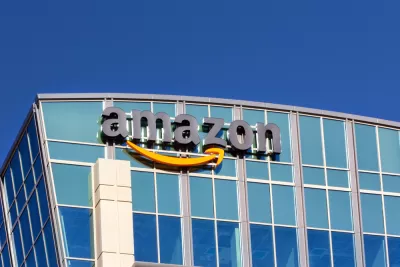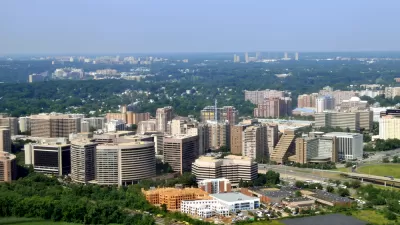Renderings for the second phase of Amazon's second headquarters in Northern Virginia grabbed a lot of attention today.

"Amazon unveiled plans Tuesday to build a futuristic building modeled after a double helix to serve as the centerpiece of its Arlington, Va., headquarters," reports Frederick Kunkle.
Double helix might by the descriptor of choice from Amazon's perspective, but armchair critics on social media are also deploying words like drill bit, ice cream cone, and poop emoji.
Whatever you see when you look at the rendering (click through to the source article for the rendering), it's impossible to deny that the building, designed by architectural firm NBBJ, would be a unique and striking addition to the Northern Virginia skyline.
The 350-foot-tall building is intended as an "alternative workspace," according to Kunkle, "where employees would be able to air out ideas and find downtime beyond their cubicles."
"Trees dot terraces along two walkways that spiral upward, evoking the feel of a stroll through the Blue Ridge Mountains. The streetscape below, with wood-frame retail pavilions and green space, is designed to appeal to people and keep them around when the workday ends," according to Kunkle.
The development plan also includes a community center, an amphitheater, a dog run, new bicycle lanes, and 2.5 acres of green space—the last in that list would be open to the public.
Amazon submitted plans today seeking county approval for the second phase of development. "Construction on the Helix and related office complexes is expected to begin in 2022 and wrap by 2025," according to Kunkle. The company has already begun construction on two office towers in the Metropolitan Park section of Amazon's new headquarters.
FULL STORY: Amazon unveils Helix building as heart of HQ2 campus in Arlington

Alabama: Trump Terminates Settlements for Black Communities Harmed By Raw Sewage
Trump deemed the landmark civil rights agreement “illegal DEI and environmental justice policy.”

Study: Maui’s Plan to Convert Vacation Rentals to Long-Term Housing Could Cause Nearly $1 Billion Economic Loss
The plan would reduce visitor accommodation by 25% resulting in 1,900 jobs lost.

Why Should We Subsidize Public Transportation?
Many public transit agencies face financial stress due to rising costs, declining fare revenue, and declining subsidies. Transit advocates must provide a strong business case for increasing public transit funding.

Paris Bike Boom Leads to Steep Drop in Air Pollution
The French city’s air quality has improved dramatically in the past 20 years, coinciding with a growth in cycling.

Why Housing Costs More to Build in California Than in Texas
Hard costs like labor and materials combined with ‘soft’ costs such as permitting make building in the San Francisco Bay Area almost three times as costly as in Texas cities.

San Diego County Sees a Rise in Urban Coyotes
San Diego County experiences a rise in urban coyotes, as sightings become prevalent throughout its urban neighbourhoods and surrounding areas.
Urban Design for Planners 1: Software Tools
This six-course series explores essential urban design concepts using open source software and equips planners with the tools they need to participate fully in the urban design process.
Planning for Universal Design
Learn the tools for implementing Universal Design in planning regulations.
Smith Gee Studio
Alamo Area Metropolitan Planning Organization
City of Santa Clarita
Institute for Housing and Urban Development Studies (IHS)
City of Grandview
Harvard GSD Executive Education
Toledo-Lucas County Plan Commissions
Salt Lake City
NYU Wagner Graduate School of Public Service





























